In this week’s blog, we explore the latest data on weekly deaths in the UK. Total weekly deaths have unfortunately continued the steady rise seen over the past few weeks, driven by the resurgence of deaths which mention COVID-19 on the death certificate.
While non COVID-19 linked deaths have remained below average, the impact of COVID-19 deaths is such that total deaths registered in the latest week were around 15% higher than the seasonal average for the week.
Since our last update on weekly deaths, England’s nationwide lockdown has continued, while Wales and Northern Ireland have finished their own respective lockdowns, but have retained some nationwide restrictions. Meanwhile, Scotland has today announced that 11 councils will be moving to the highest tier of regional restrictions from this Friday, for a three-week period.
COVID-19 cases in the UK have continued to rise, albeit more gradually than in late September. Numbers for hospitalisations of COVID-19 patients have also been rising again recently. Sadly, it is inevitable that a proportion of these new cases will require hospital treatment, and some of those will tragically die. Therefore concerns remain that we could see many more COVID-19 linked deaths in the weeks ahead.
Deaths directly attributable to COVID-19 continue to increase
The latest statistics from the ONS include detailed breakdowns of deaths registered in England & Wales up to 6th November. In particular, they identify deaths where there is any mention of COVID-19 on the death certificate. Combining this information with similar data from the corresponding statistical bodies in Scotland and Northern Ireland, we can examine emerging patterns in the data.
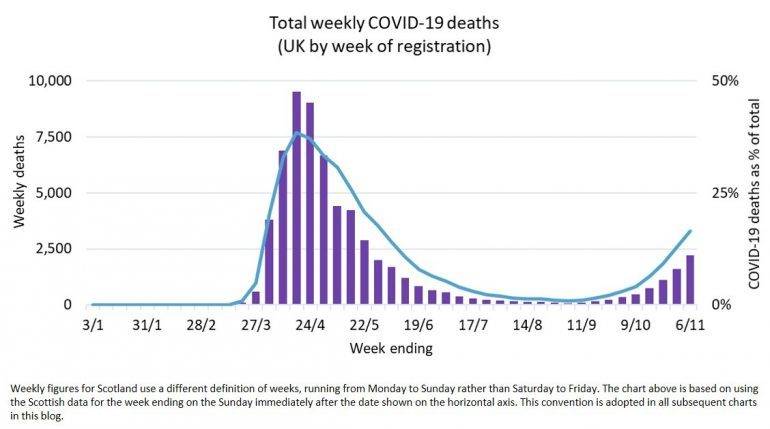
COVID-19 deaths have been increasing steadily over recent weeks, with almost 17% of deaths in the most recent registered week mentioning COVID-19 on the death certificate. The direction of travel is concerning - particularly as cases continue to rise across much of the country, with the imminent arrival of winter bringing further pressures on NHS services.
Weekly deaths increasingly above average seasonal levels
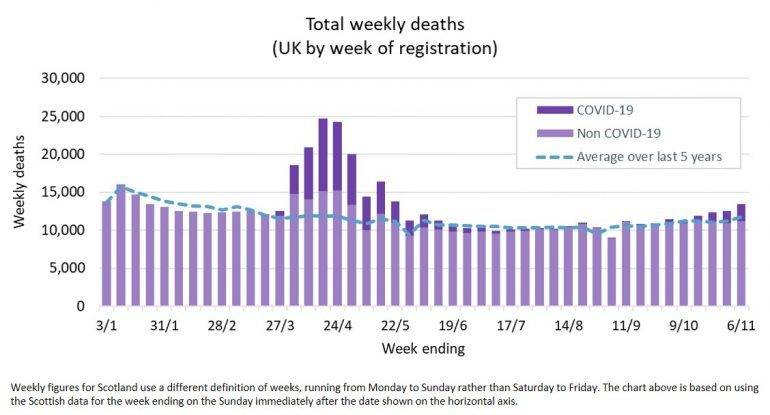
Total deaths remain above the 5-year average, for the ninth consecutive week, with the number of excess deaths increasing steadily over the past few weeks. This increase has, however, been driven by the continued rise in deaths directly attributable to COVID-19, as mentioned above. Weekly deaths excluding those linked to COVID-19 have been close to, if not below, average for the past few weeks, as can be seen from the chart below.
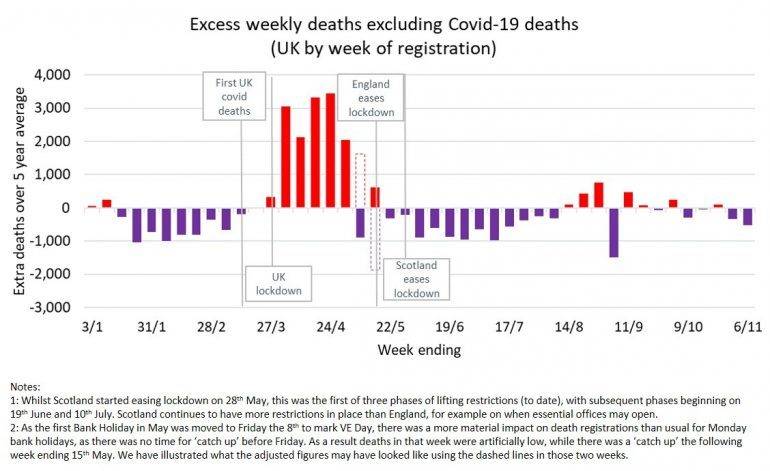
The bars shaded in red indicate weeks where total deaths were above average seasonal levels. This effect was particularly evident at the same time as the COVID-19 pandemic first hit the UK over April and May and was explored as ‘missed’ COVID-19 linked deaths in our earlier blog. Since then weekly non COVID-19 deaths have been much closer to, and for a number of weeks below, seasonal levels.
Given the statistical ‘noise’ in weekly death figures, caution is required when looking at this data over relatively short periods. It will, however, be important to monitor how these figures evolve over the next few months, where deaths would be expected to increase in any given year over the winter.
Comparing cases, hospitalisations and deaths
The chart below shows the latest case numbers published by the UK government (as of the morning of 5th November). The bars show the daily numbers of new COVID-19 cases across the UK, whilst the line shows the running seven-day average, smoothing through dips in new case numbers which tend to happen at weekends and bank holidays, for example.
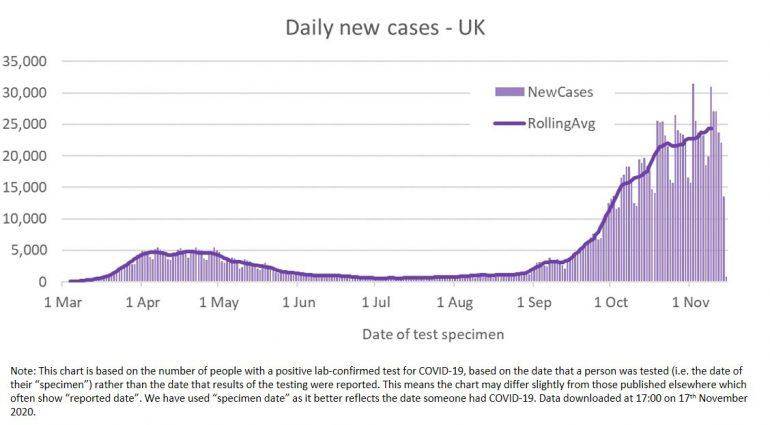
As cases continue to rise in England, authorities will be hoping the nationwide lockdown, which came into force on 5th November and is due to end on 2nd December, will begin to have an impact over the next few weeks. The two week firebreak in Wales finished on 9th November, and cases appear to have dropped significantly from the peak at the end of October. In Northern Ireland the four week circuit breaker appears to have also helped bring down case numbers, although the most recent data shows some signs of this reduction leveling off. Meanwhile, Scotland has so far resisted nationwide restrictions, implementing a 5 tier alert system. While cases have fallen at the national level, across much of the central belt cases remain at a high level. This was one of the factors behind todays announcement that these council areas would move to the highest tier for a three week period from this Friday.
While case numbers grab most of the headlines, we know that many people infected with COVID-19 have relatively mild symptoms, with some cases being entirely asymptomatic. However, there will unfortunately be a number of more severe cases which require hospital treatment and, in the most serious cases, intensive care facilities. Sadly, while medical treatments have improved markedly since the start of the pandemic, a number of those admitted to hospital will tragically die. The progression from first infection, to developing serious symptoms requiring hospitalisation, to death occurring typically takes a number of weeks.
It is therefore very useful to look at the numbers of COVID-19 cases, as an indicator of imminent hospitalisation requirements, and to look at hospitalisation figures themselves as an indicator of future rises in COVID-19 linked deaths. The chart below compares these three figures for the UK as a whole (with averaging over 7 days applied in each case to smooth out variations, such as that occurring at weekends and bank holidays). We have focussed on the figures for the past few months, given the very low levels seen over the summer.
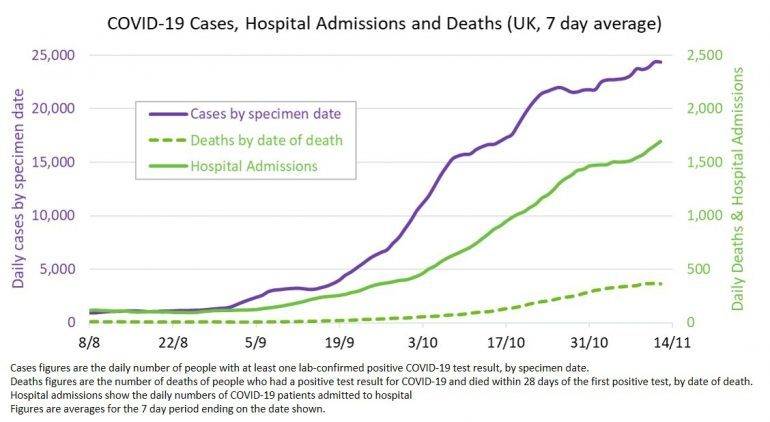
We can see how COVID-19 cases in the UK (purple line, left hand axis) have been increasing fairly rapidly since early September, as discussed above. As expected, there has been some lag between the increase in cases and corresponding rises in hospitalisations (solid green line, right hand axis), with a further lag in the rise in deaths.
There will not be direct correlation between these figures, for example impacts may depend on the changing rates of infection across different age groups, who are likely to have differing levels of hospitalisation. Nonetheless, there are concerns that, even if recent tightening of restrictions have the desired impact of slowing the rise in COVID-19 cases, as hinted at in some recent data, COVID-19 linked hospitalisations are likely to continue to increase over the weeks ahead at a time when NHS services would, in normal circumstances, expect to face increased pressures during winter.
Time will tell whether there will be further bad news on COVID-19 deaths throughout the rest of the year – we will be sure to keep our eyes on the emerging data to quickly identify any early signals.
"All of the team at Club Vita wish to extend our condolences to anyone who has personally been touched by bereavement in recent months. We know that these deaths leave behind people who are missing loved ones. Our thoughts are with you…”




